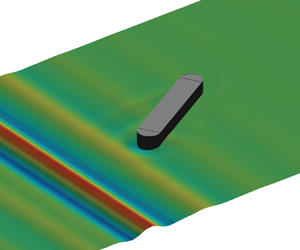Published online by Cambridge University Press: 29 January 2021

Extreme wave runup around a simplified representative floating production, storage and offloading vessel hull with a vertical bow is studied using computational fluid dynamics, complemented by experimental and diffraction analysis. This is a highly nonlinear system involving large vessel motions and extreme surface waves, and the behaviour is important for offshore design and operations. A separation method based on phase manipulation is carried out to facilitate the extraction of harmonics associated with the Stokes expansion of nonlinear waves. The separation method is applied to numerical and experimental data, and found to work well even for a highly nonlinear wave field scattered from a freely floating ship-shaped body. It is found that both low- and high-frequency second harmonic components can lead to wave runup at significantly higher levels than predicted by a linear analysis, while the vessel motions are very close to linear. The nonlinearity in the local wave field rather than vessel motion is key for the excitation of nonlinear extreme runup.
Movie 1: The full interaction of the head-on wave group with the fixed FPSO in terms of low-frequency 2nd harmonic component. The magnitudes are scaled up by 10 to improve visibility, and the same scale as in Movie 2 (i.e. linear component) is used for the non-dimensionalization to keep consistency.
Movie 2: The full interaction of the head-on wave group with the fixed FPSO in terms of linear (1st harmonic) component. The magnitudes are non-dimensional by dividing by $A$.
Movie 3: The full interaction of the head-on wave group with the fixed FPSO in terms of high-frequency 2nd harmonic component. The magnitudes are scaled up by 10 to improve visibility, and the same scale as in Movie 2 (i.e. linear component) is used for the non-dimensionalization to keep consistency.
Movie 4: The full interaction of the head-on wave group with the fixed FPSO in terms of 3rd harmonic component. The magnitudes are scaled up by 30 to improve visibility, and the same scale as in Movie 2 (i.e. linear component) is used for the non-dimensionalization to keep consistency.
Movie 5: The full interaction of the head-on wave group with the fixed FPSO in terms of 4th harmonic component. The magnitudes are scaled up by 50 to improve visibility, and the same scale as in Movie 2 (i.e. linear component) is used for the non-dimensionalization to keep consistency.
Movie 6: Same as Movie 1 but for a fixed FPSO with incoming wave incident from 30 degrees.
Movie 7: Same as Movie 2 but for a fixed FPSO with incoming wave incident from 30 degrees.
Movie 8: Same as Movie 3 but for a fixed FPSO with incoming wave incident from 30 degrees.